
The Armed Forces of the Republic of Tajikistan, also known as the Tajik National Army is the national military of the Republic of Tajikistan. It consists of Ground Forces, Mobile Forces, and the Air Force, with closely affiliated forces including the national guard, border and internal troops.
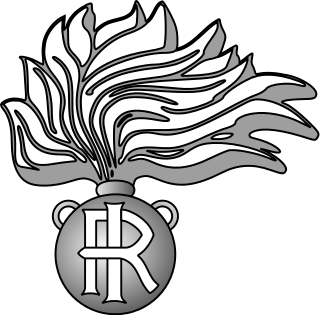
The Carabinieri are the national gendarmerie of Italy who primarily carry out domestic and foreign policing duties. It is one of Italy's main law enforcement agencies, alongside the Polizia di Stato and the Guardia di Finanza. As with the Guardia di Finanza but in contrast to the Polizia di Stato, the Carabinieri are a military force. As the fourth branch of the Italian Armed Forces, they come under the authority of the Ministry of Defence; for activities related to inland public order and security, they functionally depend on the Ministry of the Interior. In practice, there is a significant overlap between the jurisdiction of the Polizia di Stato and Carabinieri, although both of them are contactable through 112, the European Union's Single Emergency number. Unlike the Polizia di Stato, the Carabinieri have responsibility for policing the military, and a number of members regularly participate in military missions abroad.

The Panamanian Public Forces are the national security forces of Panama. Panama is the second country in Latin America to abolish its standing army, with Panama retaining a small paramilitary security force. This came as a result of a U.S. invasion that overthrew a military dictatorship which ruled Panama from 1968 to 1989. The final military dictator, Manuel Noriega, had been belligerent toward the U.S. culminating in the killing of a U.S. Marine lieutenant and U.S. invasion ordered by U.S. President George H. W. Bush.
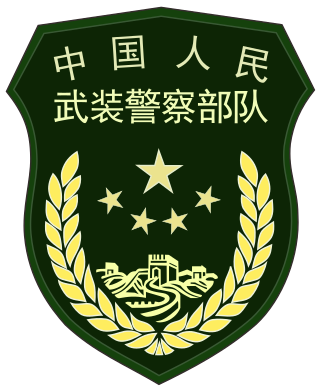
The Chinese People's Armed Police Force is a Chinese paramilitary organization primarily responsible for internal security, riot control, counter-terrorism, disaster response, law enforcement and maritime rights protection as well as providing support to the People's Liberation Army (PLA) during wartime.

Military police (MP) are law enforcement agencies connected with, or part of, the military of a state. In wartime operations, the military police may support the main fighting force with force protection, convoy security, screening, rear reconnaissance, logistic traffic management, counterinsurgency, and detainee handling.

A gendarmerie is a military force with law enforcement duties among the civilian population. The term gendarme is derived from the medieval French expression gens d'armes, which translates to "men-at-arms", or "rural police". In France and some Francophone nations, the gendarmerie is a branch of the armed forces that is responsible for internal security in parts of the territory, with additional duties as military police for the armed forces. It was introduced to several other Western European countries during the Napoleonic conquests. In the mid-twentieth century, a number of former French mandates and colonial possessions adopted a gendarmerie after independence. A similar concept exists in Eastern Europe in the form of Internal Troops, which are present in many countries of the former Soviet Union and its former allied countries.

The Maldives National Defence Force is the national military responsible for defending the security and sovereignty of the Maldives. It is primarily responsible per the constitution to defend and protect the Republic, its territorial integrity, its exclusive economic zone (EEZ) and the people.
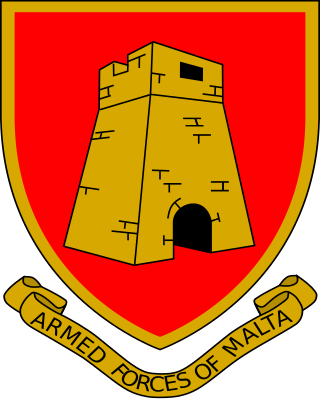
The Armed Forces of Malta is the name given to the combined armed services of Malta. The AFM is a brigade sized organisation consisting of a headquarters and three separate battalions, with minimal air and naval forces. Since Malta is the guardian of the European Union's southernmost border, the AFM has an active role in border control.

The Royal Air Force Police (RAFP) is the service police branch of the Royal Air Force, headed by the provost marshal of the Royal Air Force. Its headquarters are at RAF Honington and it deploys throughout the world to support RAF and UK defence missions.

The United States Air Force Security Forces (SF) are the ground combat force and military police service of the U.S. Air Force and U.S. Space Force. The USAF Security Forces were formerly known as Military Police (MP), Air Police (AP), and Security Police (SP) at various points in their history. Due to its significant ground combat mission, Security Forces are often regarded as Air Force infantry within the Air Force and were formed on the premise of being the Air Force's "Marine Corps", in that they would provide security for the Air Force similar to how the Marines provide security for the Navy.

The Argentine National Gendarmerie is the national gendarmerie force and corps of border guards of the Argentine Republic. It has a strength of 70,000.
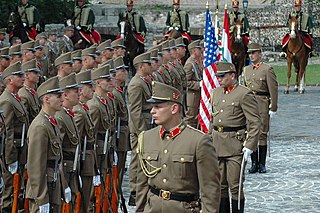
A guard of honour (GB), also honor guard (US), also ceremonial guard, is a group of people, usually military in nature, appointed to receive or guard a head of state or other dignitaries, the fallen in war, or to attend at state ceremonials, especially funerals. In military weddings, especially those of commissioned officers, a guard, composed usually of service members of the same branch, form the sabre arch. In principle, any military unit could act as a guard of honour. However, in some countries certain units are specially designated to serve as a guard of honour, as well as other public duties. Republican Guards, Royal Guards and foot guards frequently have ceremonial duties assigned to them.

The National Gendarmerie is one of two national law enforcement forces of France, along with the National Police. The Gendarmerie is a branch of the French Armed Forces placed under the jurisdiction of the Ministry of the Interior, with additional duties from the Ministry of Armed Forces. Its responsibilities include policing smaller towns, suburbs and rural areas, along with special subdivisions like the GSPR. By contrast, the National Police is a civilian law enforcement agency that is in charge of policing cities and larger towns. Because of its military status, the Gendarmerie also fulfills a range of military and defence missions, including having a cybercrime division. The Gendarmerie has a strength of around 102,269 people.
Internal security is the act of keeping peace within the borders of a sovereign state or other self-governing territories, generally by upholding the national law and defending against internal security threats. Responsibility for internal security may range from police to paramilitary forces, and in exceptional circumstances, the military itself.

The Mobile Gendarmerie (GM) is a subdivision of the French National Gendarmerie whose main mission is to maintain public order and general security. Contrary to the Departmental Gendarmerie, whose jurisdiction is limited to specific parts of the territory, the Mobile Gendarmerie can operate anywhere in France and even abroad as the Gendarmerie is a component of the French Armed Forces. Although the term "mobile" has been used at different times in the 19th century, the modern Mobile Gendarmerie was created in 1921.

The Royal Australian Corps of Military Police (RACMP) is a corps within the Australian Army. Previously known as the Australian Army Provost Corps, it was formed on 3 April 1916 as the ANZAC Provost Corps. It is responsible for battlefield traffic control, security duties, prisoner of war handling, the investigation of service offences, maintaining discipline and the running of military prisons. Its name was changed in 1918 and it was disbanded in 1920. The corps was reformed during World War II and was granted the "Royal" prefix in 1948, adopting its current name on 4 September 1974. The then Duchess of Cornwall became the first Colonel-in-Chief of the Royal Australian Corps of Military Police in November 2012. The Royal Australian Corps of Military Police have played a role in World War I, World War II and aided in conflicts since the finish of the second world war, including Afghanistan and the Timor Leste Crisis. The Corps have embellishments such as the Governor General’s banner which they received in 2001. As well as specific uniform requirements up to and including their standout scarlet beret. The Military Police has a range of training pathways which leads to the many different specialised roles the members hold.
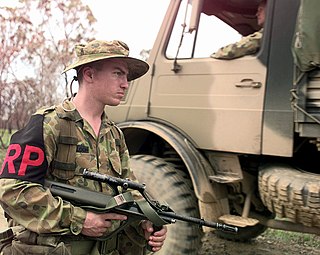
Regimental police or regimental provost (RP) are soldiers responsible for regimental discipline enforcement and unit custody in the British Army, other Commonwealth armies and some armed forces structured in the British tradition. They belong to the regiment or corps in which they enforce discipline rather than the Royal Military Police or its equivalent.
RNZAF Security Forces is the Royal New Zealand Air Force unit responsible for base security, ground defence, weapons training, and Air Transport Security on RNZAF aircraft. RNZAF Security Forces operates under the RNZAF Operations Squadron.

The Mauritius Police Force (MPF) is the national law enforcement agency of Mauritius. The MPF carries out police, security, and military functions on Mauritius, with about 12,500 police officers under the command of the Commissioner of Police. The MPF is part of the Home Affairs Division, which operates under the aegis of the Prime Minister's Office.

Air force ground forces and special forces are the land warfare forces of an air force. They may include infantry, special forces, security forces, and military police. Airmen assigned to such units may be trained, armed and equipped for ground combat and special operations.

















